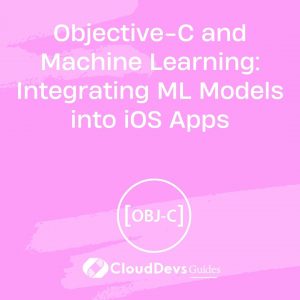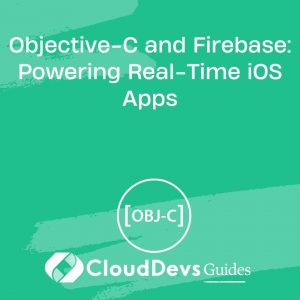Objective-C and Machine Learning: Integrating ML Models into iOS Apps
In today’s fast-paced world, mobile applications have become an integral part of our daily lives. As the demand for smarter, more personalized apps continues to grow, integrating Machine Learning (ML) into iOS apps has become a game-changer. In this blog, we will explore how you can harness the capabilities of Objective-C, a powerful and versatile programming language, to seamlessly integrate ML models into your iOS applications.
Table of Contents
1. Why Integrate Machine Learning into iOS Apps?
1.1. Enhancing User Experience
Machine Learning can elevate user experiences to new heights. It allows your iOS app to understand user preferences, adapt to their behavior, and provide tailored recommendations. Whether it’s suggesting personalized content or predicting user actions, ML can make your app feel like it’s truly one step ahead.
1.2. Improved Decision Making
ML models can process vast amounts of data to make informed decisions in real-time. In an iOS app, this can translate to optimizing routes in navigation apps, detecting fraudulent activities in financial apps, or even identifying objects in photos and videos.
1.3. Automation and Efficiency
By automating repetitive tasks, ML models can help reduce manual effort and increase efficiency. Imagine an iOS app that automatically categorizes and tags user-generated content or one that translates text in real-time using a custom language model.
2. The Power of Objective-C in iOS App Development
Before diving into the integration of ML models, let’s briefly discuss why Objective-C is an excellent choice for iOS app development.
2.1. Proven Track Record
Objective-C has been the go-to language for iOS development for many years. It’s a language with a proven track record, as it has been used in the development of countless successful apps, including some of the most popular ones.
2.2. Compatibility
Objective-C is highly compatible with Swift, Apple’s modern programming language for iOS development. This compatibility allows you to leverage existing Swift code and frameworks seamlessly.
2.3. Rich Ecosystem
Objective-C offers access to a rich ecosystem of libraries and tools that can be beneficial when integrating ML models into your iOS app. You can easily find open-source ML libraries and bindings for Objective-C.
3. Integrating Machine Learning into Your Objective-C iOS App
Now, let’s get into the nitty-gritty of integrating Machine Learning into your Objective-C iOS app. We’ll walk through the process step by step.
3.1. Choose the Right ML Framework
The first step is to select an ML framework that suits your project’s needs. Fortunately, there are several options available for Objective-C developers, including:
- Core ML: Apple’s own framework for integrating ML models into iOS apps.
- TensorFlow Lite: A popular open-source framework for ML, which provides Objective-C bindings.
- Caffe2: Another open-source ML framework with Objective-C support.
- Choose the framework that aligns with your project requirements and your familiarity with the tools.
3.2. Prepare Your ML Model
Once you’ve chosen a framework, you’ll need an ML model to integrate into your iOS app. You can either create a custom model or leverage pre-trained models available in popular ML libraries.
Here’s a code snippet for loading a Core ML model into your Objective-C project:
objective // Load the ML model NSURL *modelURL = [[NSBundle mainBundle] URLForResource:@"MyModel" withExtension:@"mlmodel"]; MLModel *model = [MLModel modelWithContentsOfURL:modelURL error:nil];
3.3. Data Preprocessing
Data preprocessing is a critical step in ML model integration. You’ll need to prepare the input data for the model and post-process the output data for meaningful results. This can include tasks such as image resizing, text tokenization, and data normalization.
objective
// Preprocess input data
NSData *inputData = [self preprocessData:inputImage];
// Make predictions
MyModelOutput *output = [model predictionFromFeatures:@{@"input": inputData} error:nil];
// Post-process output data
NSString *result = [self postprocessResult:output];
3.4. Real-Time Inference
To make your iOS app truly dynamic, you’ll want to perform real-time inference using the ML model. This means feeding data to the model as the user interacts with the app and receiving predictions on the fly.
Here’s a simplified example of real-time image classification using Core ML:
objective
// Capture an image from the camera or photo library
UIImage *inputImage = [self captureImage];
// Preprocess input data
NSData *inputData = [self preprocessData:inputImage];
// Make predictions
MyModelOutput *output = [model predictionFromFeatures:@{@"input": inputData} error:nil];
// Display the result to the user
NSString *result = [self postprocessResult:output];
[self displayResult:result];
3.5. Model Updates
Keep in mind that ML models may need updates to stay accurate over time. Fortunately, Objective-C allows you to seamlessly update your app’s ML model without disrupting the user experience. You can fetch updated models from a server and replace the old one when necessary.
objective
// Check for model updates
if ([self shouldUpdateModel]) {
// Download the updated model
[self downloadUpdatedModel];
// Replace the old model with the updated one
[self replaceModelWithNewOne];
}
3.6. Error Handling and Feedback
Effective error handling and user feedback are crucial for a smooth user experience. Make sure to provide clear messages and guidance when errors occur, such as when the ML model fails to make predictions or when network connectivity issues arise.
4. Real-Life Use Cases
Let’s explore some real-life use cases where integrating Machine Learning into iOS apps using Objective-C can make a significant difference.
4.1. Healthcare and Medical Diagnosis
Imagine an iOS app that uses ML to analyze medical images like X-rays and MRIs. Objective-C can handle the integration seamlessly, providing doctors with valuable insights, such as identifying anomalies and making preliminary diagnoses.
4.2. Language Translation
An iOS app that offers real-time language translation is incredibly useful for travelers. Objective-C can power such apps by integrating ML models that can translate spoken or written text on the go.
4.3. Retail and E-commerce
In the competitive world of e-commerce, personalized product recommendations can significantly boost sales. With ML integrated into your app, you can provide users with product suggestions based on their browsing and purchase history.
5. Challenges and Considerations
While integrating Machine Learning into iOS apps using Objective-C offers numerous advantages, it also comes with some challenges and considerations.
5.1. App Size
ML models can be large, and integrating them into your app may increase its size significantly. You’ll need to strike a balance between functionality and app size to ensure a smooth user experience.
5.2. Performance
ML models can be computationally intensive, which may impact app performance, especially on older devices. You’ll need to optimize your code and leverage hardware acceleration to maintain responsiveness.
5.3. Model Training and Updates
Keeping ML models up-to-date and accurate is an ongoing process. You’ll need a strategy for training new models and delivering updates to users effectively.
Conclusion
Integrating Machine Learning models into iOS apps using Objective-C opens up a world of possibilities for creating smarter, more personalized, and efficient applications. With the power of Objective-C and the versatility of ML frameworks, you can enhance user experiences, make informed decisions, and automate tasks with ease.
As you embark on your journey of integrating ML into iOS apps, remember to choose the right framework, prepare your data, perform real-time inference, handle updates gracefully, and consider the challenges that may arise. With the right approach, your Objective-C iOS app can become a game-changer in the world of mobile technology.
So, are you ready to take your iOS app development to the next level with Machine Learning? Start exploring the endless possibilities today!
Table of Contents









